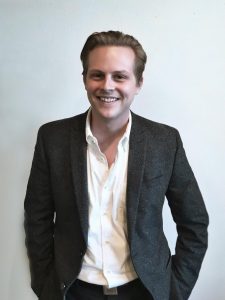ROBERT COX ’09

North Carolina native Robert Cox made a point of pursuing architecture from his first year at Wake Forest. Building a strong foundation in historical knowledge, Robert honed his creative style through Studio courses and summers abroad on architecture-focused Richter Scholarship travels. We spoke with Robert to learn more about his path into architecture.
*Since this interview, Robert moved to Raleigh, NC where he works as Project Architect II for JDavis Architects.
Architect
Robert A.M. Stern Architects
New York City, New York
WFU Class of 2009
Major: Art History
Minor: Studio Art
DeacLink: What are you currently doing at work?
Robert Cox: I have been working at a firm called Robert A.M. Stern Architects for almost four years now. It’s a medium-size office with a broad scope of residential, commercial, and institutional buildings (including the new business school at Wake Forest). I worked for two years on a multi-family residential project in New York, and then transitioned about a year ago to another part of the office, focusing on single family homes.
DL: Take us through your journey to your current occupation since graduating from Wake.
RC: I graduated from Wake in 2009 with an Art History major and a Studio Art minor, then took a year off in my hometown of Asheboro, NC to work on my portfolio and apply to grad schools. I was accepted to Columbia’s architecture program, and moved to New York in the fall of 2010. After three years of school and a summer of job hunting, I started by current job at RAMSA.
DL: Was Columbia your primary focus while selecting a graduate program?
RC: I actually cast a wide net. Because I didn’t have any previous architecture experience, I compiled a portfolio of drawing, photography, and even a little creative writing. I tried to make it speak to my interests and creative pursuits, and hoped that that would resonate with the right school.
DL: How much did your time at Wake inform or drive your career path?
RC: I had always thought I’d go into architecture, but Wake Forest was a place where I could get a liberal arts education first, before getting into this very specialized discipline. I think my time at Wake studying architectural history helped confirm for me what I wanted. Spending that time broadening my base knowledge was definitely worthwhile.
DL: Coming out of your artistic training at Wake, did you feel prepared for life after graduation?
RC: I think, specifically for architecture, I probably could’ve gotten better at digital design tools before starting school. Learning more about 3D modeling, for example, would’ve been a great head start. My first year of architecture school, I was trying to design buildings and learn software at the same time, when I should’ve just been focusing on design. So my advice to anyone going into architecture school: download or find school resources for software, and practice!
DL: Prior to what you’re doing now, what other sorts of jobs have you had? How did you find and apply to them?
RC: or better or worse, I spent my summers exploring. I took advantage of being a young college student, rather than piling on office experience. The summer of 2008, between my junior and senior year, I studied (with Wake’s help!) in Jamaica and in Italy through two different programs. In Jamaica, I joined UVA’s architecture school in their historic preservation field school, which was very cool. After that, I traveled to Rome on the Richter grant, completing an individual study of contemporary religious architecture in Italy.
DL: What’s the hardest part about breaking into your field?
RC: I was applying for jobs during the lingering aftermath of 2008, so hiring was just beginning to pick back up in the architecture world. There were more architects than there were positions, so it took me a while. Having a degree from a well-known program like Columbia helped for sure, but it was also an expensive degree — which doesn’t always compare well with an architect’s salary. So, coming from a good school is great for getting hired, but you have to be willing to pay for it (or hustle hard for that scholarship).
DL: How do you like living and working in NYC? Do you have any advice for students wanting to move there?
RC: I’ve been here six years. I was never one of those people completely enthralled by the city, but I wasn’t hating every minute, either. You meet both types here. The best advice I have is to show up ready for things to be different from just about anywhere else in the US. Be ready to go with the frenetic flow, and try to love New York even when it’s not loving you back.
DL: hat has surprised you the most about the art scene in New York?
RC: I actually live very close to the West Chelsea gallery streets, so I often walk down there on Saturday mornings to get coffee and check things out. It’s been one of the most specifically New York things that I’ve gotten to experience here. There’s a constant rotation of new and exciting art, free and open to the public.
DL: What and where is next for you?
RC: I’ll stay at my current job for the time being. I still have lots to learn, and I’m enjoying my work. The biggest thing for me next is the completion of a book I’m writing/illustrating… that’s coming down the line, hopefully soon.
DL: What’s the best kernel of advice you can think to pass on, or currently go by?
RC: I have the tendency to get pretty zoomed in on my work and stay there. And I think one thing I’ve learned that’s worthwhile: periodically take a step back and look at the big picture, and see how everything fits together.
